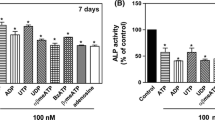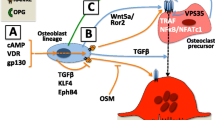Abstract
Expression of progesterone receptors (PR) was studied in human osteoblast-like cell lines and primary human osteoblast cultures at the molecular level. Using the sensitive reverse transcriptase polymerase chain reaction (RT-PCR) and oligonucleotide primers which flank the progesterone-binding domain of human PR, progesterone receptor (PR) mRNA was detected in three osteoblast-like cell lines-HOS-TE85, MG-63, and SAOS-2. When compared with β-actin gene expression, levels of PRmRNA transcripts varied between cell lines (PRmRNA in HOS-TE85>MG-63 ≫ SAOS-2). In addition, RT-PCR confirmed the presence of PRmRNA transcripts in primary human osteoblast cells cultured from collagenase-treated bone. Immunostaining was used to visualize PR protein in cells. All osteoblast-like cell lines showed specific staining for PR. Immunoreactivity was distributed equally in the nucleus and cytoplasm. The level of staining was significantly lower than that detected in PR-positive MCF-7 breast cancer cells though well above background levels obtained for PR-negative HeLa cells. The finding that PR is expressed at both the level of mRNA and protein in several osteoblast-like cell lines as well as in human primary osteoblast cultures indicates that bone-forming osteoblast cells are direct targets for progesterone action.
Similar content being viewed by others
References
Hahn TJ, Halstead LR, Teitelbaum SL, Hahn BH (1979) Altered mineral metabolism in glucocorticoid-induced osteopenoia. J Clin Invest 64:655–665
Riggs BL, Melton LJ (1986) Involutional osteoporosis. N Engl J Med 314:1676
Eriksen EF, Colvard DS, Berg NJ, Graham ML, Mann KG, Spelsberg TC, Riggs BL (1988) Evidence of estrogen receptors in normal human osteoblast-like cells. Science 241:84–86
Komm BS, Terpening CM, Benz DJ, Graeme KA, Gallegos A, Kore M, Greene GL, O'Malley B, Haussler MR (1988) Estrogen binding, receptor mRNA and biological response in osteoblast-like osteosarcoma cells. Science 241:81–84
Prior JC (1990) Progesterone as a bone-trophic hormone. Endocrine 11:2:386–398
Barbieri RL (1990) Gonadotropin-releasing hormone antagonists and estrogen-progestrogen replacement therapy. Am J Obstet Gynecol 162:593–595
Gambrell RD Jr (1989) Uses of progestrogens in postmenopausal woman. Int J Fertil 34:315–331
Grecu EO, Weinshelbaum A, Simmons R (1990) Effective therapy of glucocorticoid-induced osteoporosis with methoxyprogesterone acetate. Calcif Tissue Int 46;294–299
Manolagues SC, Anderson DC (1978) Detection of high affinity glucocorticoid binding in the rat bone. J Endocrinol 76:379–380
Chen TL, Aronow L, Feldman DL (1977) Glucocorticoid receptors and inhibition of bone cell growth in primary culture. Endocrinology 100:819–628
Orwell ES, Stribrska L, Ramsey EE, Keenan EJ (1991) Androgen receptors in osteoblast-like cell lines. Calcif Tissue Int 49: 183–187
Slootweg MC Ederveen AGH, Schot LPC, Schooner WGEJ, Kloosterboer HJ, (1992) Oestrogen and progestogen synergistically stimulate human and rat osteoblast proliferation. J Endocrinol 133:R5-R8
Wei LL, Leach MW, Miner RS, Demers LM (1993) Evidence for progesterone receptors in human osteoblast-like cells. Biochem Biophys Res Commun 195:525–532
Robey P, Termine JD (1985) Human bone cells in vitro. Calcif Tissue Int 37:453–460
Manduca P, Sanguineti C, Pistone M, Boccignone E, Sanguineti F, Santolini F, Federici A (1993) Differential expression of alkaline phosphatase in clones of human osteoblast-like cells. J Bone Miner Res 8:291–300
Chomczynski P, Sacchi N (1987) Single step method of RNA isolation by acid guanidium thiocyanate-phemol-chloroform extraction. Anal Biochem 162:156–159
Hagihara K, Hirata S, Osada T, Hirai M, Kato J (1992) Expression of progesterone receptor in the hepnatal rat brain cortex: detection of its mRNA using reverse transcription polymerase chain reaction. J Steroid Biochem Molec Biol 41:637–640
Misrahi M, Atger M, et al. (1987) Complete amino acid sequence of the human progesterone receptor deduced form cloned cDNA. Biochem Biophys res Commun 143:740–748
Horikoshi T, Danenberg K, Stradbauer THW, et al. (1992) Quantification of thymidylate synthase, dihydrofolate reductase and DT-diaphoase expression in human tumours using the polymeraes chain reaction. Cancer Res 52:108–116
Rifas L, Fausto A, Scott MJ, Avioli LV, Welgus HG (1994) Expression of metalloproteinases and tissue inhibitors of metalloproteinases in human osteoblast-like cells: differentiation is associated with repression of metalloproteinase biosynthesis. Endocrinology 134(1):213–220
Tremollieres FA, Strong D, Baylink DJ, Mohan S (1992) Progesterone and promegestone stimulate human bone cell proliferation and insulin-like growth factor-2 production. Acta Endocrinol 126:329–337
Verharr HJJ, Damen CA, Duursma, SA, Scheven BAA (1994) A comparison of the action of progestins and estrogens on the growth and the differentation of normal adult human osteoblast-like cells in vitro. Bone 15:307–311
Pensier JM, Radosevich JA, Higbee R, Langman CB (1990) Osteoclast isolated from membranous bone in children exhibit nuclear estrogen and progesterone, receptors. J. Bone Miner Res 5:797–802
Kastner P, Krust A, Turcotte B, Stroop U, Tora L, Gromemeyer H, Chambon P (1990) Two distinct estrogen-regulated promoters generate transcripts encoding the two functionally different human progesterone receptor forms A and B. EMBO J 9:1603–1614
Greene GL, Harris K, Bova R, Kinders R, Moore B, and Nolan C (1988) Purification of T47D human progesterone receptor and immunocharacterization with monoclonal antibodies. Mol Endbocrinol 2:714–726
Author information
Authors and Affiliations
Rights and permissions
About this article
Cite this article
MacNamara, P., O'Shaughnessy, C., Manduca, P. et al. Progesterone receptors are expressed in human osteoblast-like cell lines and in primary human osteoblast cultures. Calcif Tissue Int 57, 436–441 (1995). https://doi.org/10.1007/BF00301947
Received:
Accepted:
Issue Date:
DOI: https://doi.org/10.1007/BF00301947




